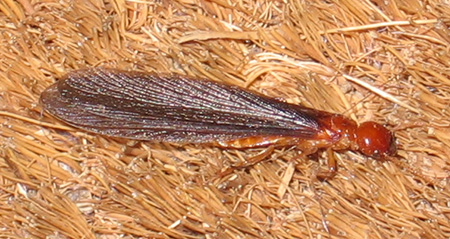
|
Macro on the move II by Erin Thomas, USA |
Editor's note: The author Erin
Thomas has recently returned from a second car journey in the
western United States and photographed the smaller fauna and
flora he came across. This was a much shorter drive than illustrated
in
Macro on the Move I, and only involved two states, though most
of the photos were taken inside Oregon. He kindly shares a selection of his
photos taken with a Canon Powershot A510 and observations
during his journey below. Any help with the identifications
would be appreciated.
Possible
termiteWillits, California:
The picture below was taken in a friend's house in Willits,
CA. I stayed with him for about a week. The first or second
night, as we were playing scrabble, I noticed this bug
flittering around the lamp shade by the front door. It was difficult to get pictures of
because it was so active. Once I got three decent
pictures (I broke off from the game of scrabble to photograph
it), I took it outside and let it go. After spending some time in one of my new insect books
to see if I could get an
idea what kind of insect it is, I've become pretty sure it's a termite,
but I look forward to finding out for certain from someone
more knowledgeable.

Unknown beetleAnandale Park in Santa Rosa,
California: Before starting my drive back
to Portland from the Willits area, I went to visit a friend in
Santa Rosa. We took a walk in a regional park called Anandale,
and I had my camera along in case I saw anything. As we walked
I noticed this beetle moving across the trail. I feel like I should have
been able to get better pictures, but I think I was still
adjusting to the camera after having gone a month and a half
without using it.
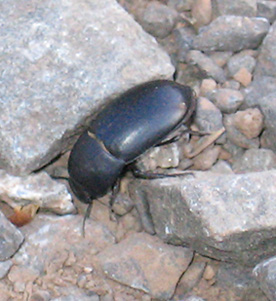
Two flowering plantsAnandale Park in Santa Rosa, California: Later in the walk I
decided to experiment some with the camera settings using
these two flowering plants. I would like to learn what these flowers
are called. I especially like the photo to the right because it shows this flower
in three of its stages: as a bud,
a blossom, and going to seed.
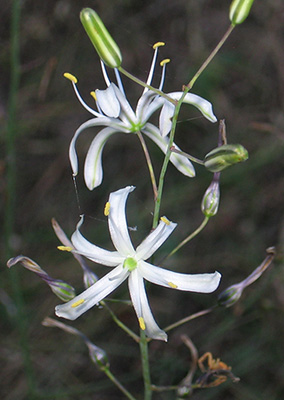
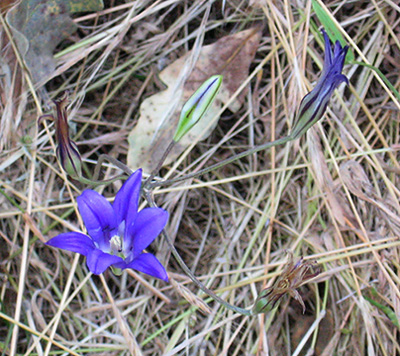
From the Willits area, I drove straight
to Redding, California, where I could meet Hwy 299, which travels
through some mountains
to the northeast corner of California and into Oregon. I spent the night off
the road about 2 miles east of its junction with Hwy 89, which
goes between the Mount Shasta area and Susanville, California.
These next three insects were
photographed the following morning after I stumbled out of my car
and yawned my way into the
woods to see what sort of critters I might encounter. I followed butterflies around
for awhile, but never
managed to get a picture of one. Somehow, I want to learn how to be
crafty enough to pull this off.
Unknown insectoff of Hwy 299,
California:
In fact, I had trouble getting photos of any large insect. It
was very warm, and maybe this fact was giving them lots of
alertness and energy. I decided to take pictures of these
insects that seemed to be feeding on nectar from the flowers. I took lots of pictures, experimenting a
lot with the camera's settings. Although other photos
came out clearer, the first photo below seems to offer the most
detailed view of the insect's characteristics. I'm wondering if
they're beetles of some sort.

I like the effect of cropping this next photo so that there is a view of three insects between the two tufts of flowers:
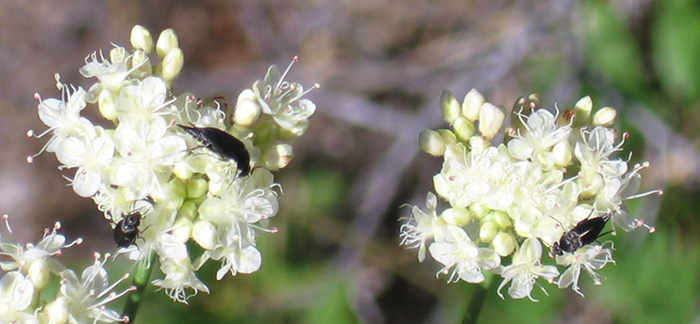
Unknown termiteoff Hwy 299,
California: I was becoming pretty dismayed because I wasn't able to
get any photos of butterflies, grasshoppers, bees, or wasps. They
were around, but they just weren't posing for me. So I
started looking for insects that maybe didn't move so fast,
which I figured might be under rocks and downed wood. Carefully, I
lifted rocks and rotting wood up to see what might
be underneath. Larger insects were revealed in a couple of cases, but even
these
were too fast for me to photograph, scurrying back under the dirt or
other cover before I
could get my first shot.
This colony of termites took a few minutes to burrow
down out of sight when I lifted up a large piece of deadwood. I'm pretty sure these are termites because of the
soldier (the one termite in the right hand picture with a large
orange head and big jutting mandibles). There were still some
that hadn't burrowed out of sight when I filled up the memory
card, so I carefully put the deadwood back on top of them:
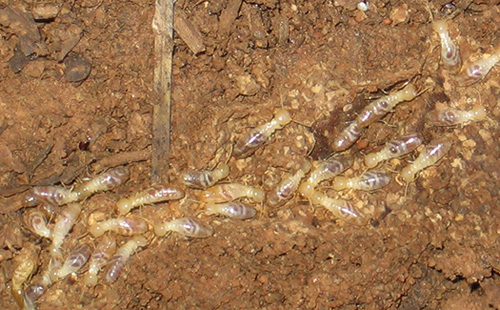

Unknown beetleoff of Hwy 299,
California: As I neared my car again I noticed this beetle,
which seemed to be eating the petals of a flower. Although the
beetle was shy, it was not as shy as everything else that day. I
was able to follow it around as it flew between
a few plants in an effort to evade me. Here I'm pulling the petal of
a
flower back so I can see the whole beetle. None of the other photos
I took captured the entire beetle. It worked very effectively to
stay out of direct line of sight from me.
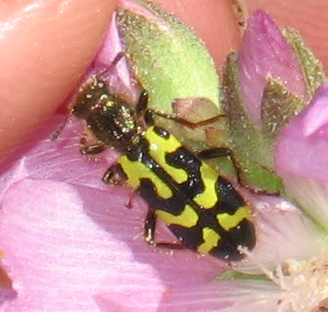
The following three insects were photographed off of Hwy 299 about 40 miles north of Burns in Oregon. I had turned down a small unmarked dirt road to stretch my legs and relieve myself out of view of the highway. Much to my surprise, there was a mile long paved interpretive walking trail about a half-mile up the road. There was no sign by the highway indicating that it would be there, and it looked as if it may have been there for several decades. The sun was about an hour away from setting and I was swarmed by mosquitoes whenever I stopped to snap a picture. Eventually it seemed as if they passed the news about my fresh blood along the mosquito grape-vine, and it soon became impossible for me to concentrate on taking photos despite seeing many interesting insects aside these three.
Unknown somethingoff of Hwy
299, Oregon:
I seem to recall hearing about or seeing on some documentary a
beetle that creates hydrogen peroxide to clean itself, but I
get the feeling this insect might be molting. I have no idea
if it's the same beetle that I heard about that creates
hydrogen peroxide. The view of the insect isn't very clear
because of the bubbly fluid it has generated around itself,
but it's interesting nonetheless:
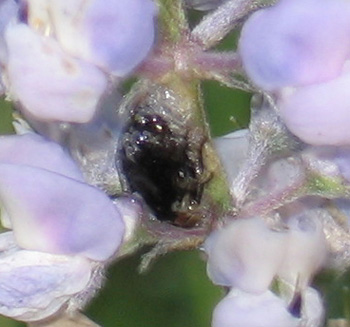
Unknown plume mothoff of Hwy
299, Oregon: I
spent about an hour and a half in my insect book trying to key
my way to this insect, but I finally gave up and just flipped
through the pages one at a time until I saw an illustration
that seemed to be the one. If I knew to look for the hairy
wings, I may have gone straight to it on the first shot.
I'm pretty sure this is a plume moth, though I don't know what
kind. I figured the way it held its wings at rest
must
give some kind of solid indication
of its family (which is family Pterophoridae if I've got it right) so I made a
special effort to figure this one out.
This one stood still for me while I jerked and spasmed as mosquitoes
bit me just about everywhere:
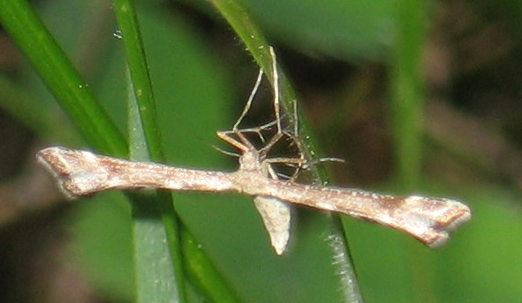
Possible Eliodesoff of Hwy 299, Oregon: Mosquitoes were becoming more persistent at this point, so I forgot to increase the exposure, or I would have gotten better pictures.
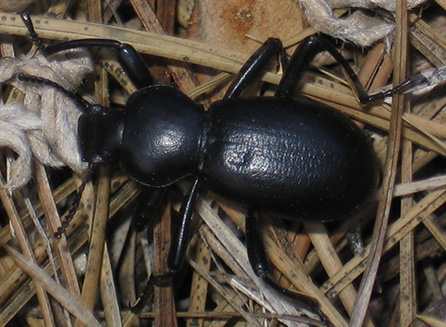
Scene-setter: The following insect photos were all taken in the general vicinity of these mountains. This photo of Enterprise, Oregon shows a portion of the Wallowa mountains in the background to the south. NF 39 runs through the east side of the Wallowa Mountains.
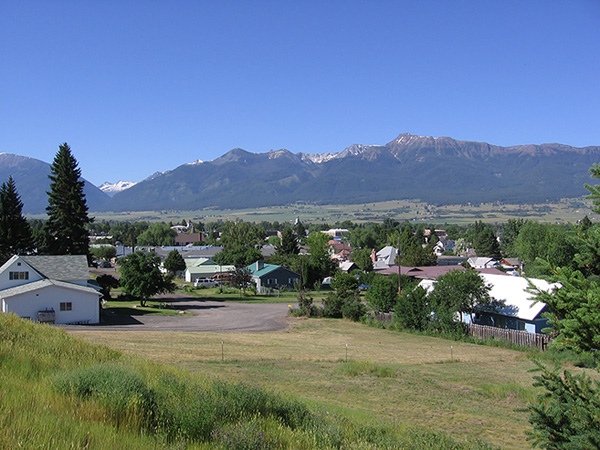
The Hells Canyon
Overlook is about three miles west of NF (National Forest route) 39
in northeast Oregon next to the border of Idaho. In fact, when you
look across the canyon, you're looking at Idaho. The following five
insects were photographed about three hours from sunset.
The Overlook is fairly well developed, equipped with
rustic toilets, a pretty elaborate parking lot, and a
paved interpretive trail with offshoots to picnic areas that each
have a view of the canyon.
When I showed up there were people snapping photos of the
canyon itself. Scenic photos have always seemed pretty boring to me. I've found that it
is next to impossible to snap a photo that captures even a
fraction of the grandeur of such scenes. I generally only photograph things like canyons.
mountains, plains, and other sorts of horizon-scapes when I can find
some very interesting feature to include in the foreground of the
photo, like an unusual tree, rock formation, dilapidated old
building or sign, etc.Otherwise, I just end up
with a lot of photos that look about the same. So I tried to find
some place out of sight of the people who were snapping photos of
the canyon to look for bugs.
Unknown mothHells Canyon Overlook, Oregon: This moth flittered by me and I tracked it to a bush where I snapped about six photos of it. Gaining this vantage point required that I cram my head into a neighboring bush. This is one of two that turned out alright.
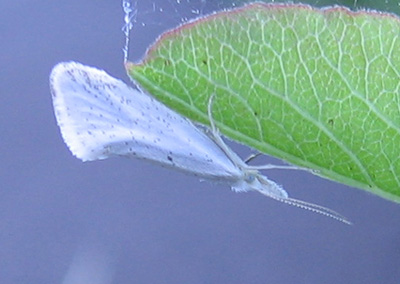
Unknown mothHells Canyon Overlook, Oregon: This moth has a similar configuration but darker coloration to the first moth I photographed. Although this moth attempted to hide under things out of sight, I managed to get a good top-down photo of it as well as a side shot. This was cheerful-making for me.
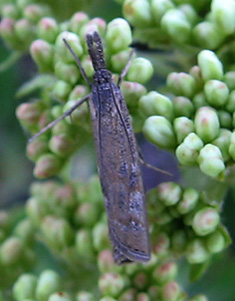

Possible Eliodes beetleHells Canyon
Overlook, Oregon: This beetle
looks very much like the one I took photos of the night before. Out of
the several photos I have of this beetle, this one feels like the only one worth sharing. The rest are
alright, but this one is startling in its clarity:
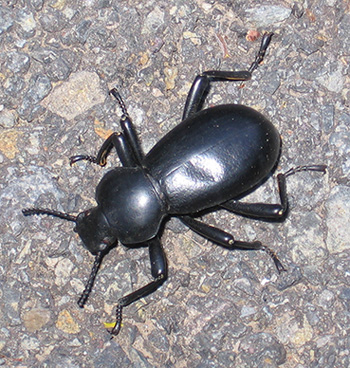
Unknown beeHells Canyon
Overlook, Oregon: This
looks to me like a bumble bee, but I don't yet know how to identify
bees. I took this photo from the paved walking trail surrounded by noisy tourists
of all ages, some of which had
dogs. Very distracting. Most of them had cameras, and I could
feel their eyes bearing down on me from all sides. This photo shows off the wings pretty well. I got the
whole flower into the cropping since bees and flowers go hand in
hand:
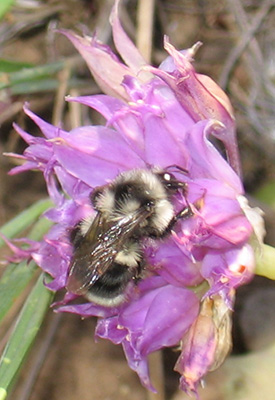
Unknown beetleHells Canyon
Overlook, Oregon: From the footpath I
noticed a very large insect rise up from
the plants in the field to the north. Unable to
help my curiosity, I carefully picked my way out toward where I saw
the insect settle back down again, careful not to
step on plants that may not have pollinated yet, walking across the tops of small exposed rocks as best I
could.
I couldn't find the insect I saw, but before heading back I
snapped a picture of this beetle:
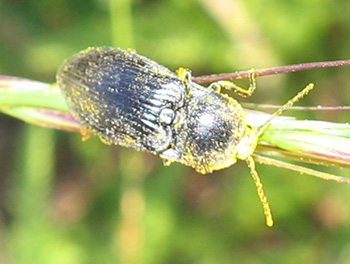
It dropped off the reed it was on as I bent the reed hoping to get better lighting, and when I picked it up it played dead in my hand, feet curled in across its abdomen and bent inward a bit. It reminded me of a beetle that can click itself, popping up into the air. But this beetle didn't do that. It was being so uninteresting in its dead mode that I put it back down on the ground where it fell without taking any further photos. As I started walking away I noticed it darting for cover.
Much to my dismay, when I turned my attention back to the footpath, I noticed three other people were now in the field snapping pictures of plants (they didn't realize I was snapping pictures of insects) and two more snapping pictures of plants from the footpath. I had no idea that could happen. If I had known that my actions would cause other people to trample out unceremoniously into the field, disturbing the soil, seeds, flowers, and other life, I wouldn't have gone out myself. A valuable lesson, and I should have known better since an entomologist friend of mine won't even leave tracks when he leaves the trail for his research because he says he'll come back a month later to find the area where he left the trail trampled down by excessive foot traffic.
You might wonder why I say these people didn't realize I was snapping photos of insects. I asked the photographers closest to my car who had their camera pointed at a tuft of flowers what kind of insects they were taking pictures of, and they both (a couple) replied, "There don't seem to be any insects around." I couldn't help rolling my eyes as I continued back to my car. The air was full of insects, never mind the plants. It's probably good for the bugs, however, that most people don't seem to realize they're there.
This couple was at least staying on the footpath, as I should have done. I generally only veer from the beaten path when no others are around since I can count on myself to be careful with the life around me, even if I am sometimes clumsy about it. The insect I saw that caused me to wander off into the fields was probably about the size of my fist, had two great big sets of wings, and a long arching body. I really wanted a closer look at it!
When I left Hells Canyon Overlook, I returned to NF 39 and continued north hoping to find a place to sleep for the night before it became too dark to look effectively. I did find a decent place about an hour later. It was about two miles west of NF 39 off of a dirt road that follows a ridge from where NF 39 crests a 5,900 foot saddle. A series of large fields sloped down from the ridge, offering a view of mountains and ridges to the south. I could have found some bugs to photograph, but the mosquitoes were out in force, and I was still nursing my wounds from the night before.
Unknown mothtwo miles west of NF 39, Oregon:
However, during the night (I sleep in my car), something
brushed my ear and woke me up. It was a large moth. I
took several photos of it hoping to learn more about
photographing bugs in the dark (near dark since I had the dome
light on, which isn't very bright). When I was finished I opened the
window and herded it out of the car into the engulfing night. Not the best photos, but it was
nice to get some shots to see what I could accomplish. It was
so dark in the car that the images looked much brighter on the
camera's display than they actually ended up being once they were transferred over to my computer. Hopefully I'll remember this
and go for longer exposures and slower shutter speeds next
time, settling for photos that seem too bright
on the camera's display. I actually deleted a bunch of them off the
camera to make space for darker ones that I thought looked better at
the time:
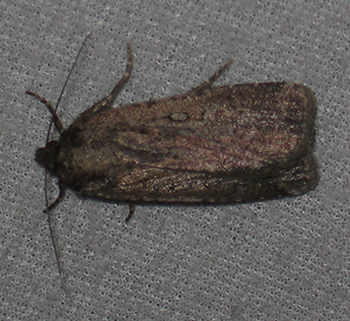
These next three insects were photographed the following morning along NF 39 about ten miles north of where I had turned off to find a sleeping spot for the night.
Unknown insectOff of NF 39, Oregon:
The first insect I came across was this
one, which I'm pretty sure it is in the family Lygaeidae. Maybe someone can tell me
for sure. The bug that's crawling off over the edge of the flower was a moment
ago on top of the one still in the middle of the flower. After it
crawled down under the petals it turned around and poked its head
out to see what was going on:
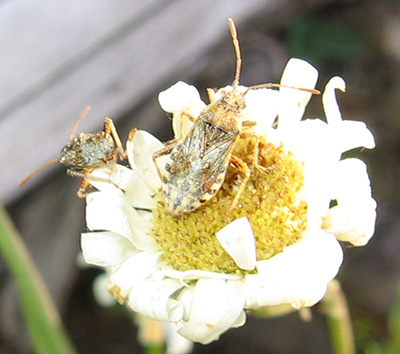
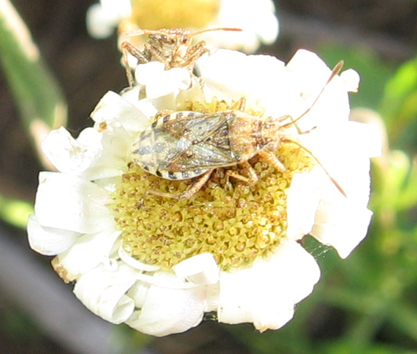
Unknown flyOff of NF 39, Oregon:
I had to duck under some low-hanging branches from a pine tree to get a picture of this fly. I'm hoping that I'll be able to get larger pictures with more detail in the future now that I have a close-up lens that will enlarge the subject I'm focused on. Still, I'm not unhappy with the detail in this photo:
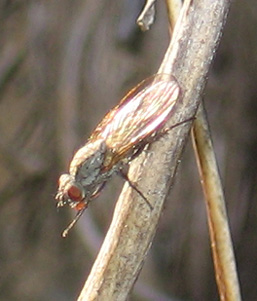
Unknown flyOff of NF 39,
Oregon: Found about five of these yellow jacket like flies in my car when I got back to it.
I left my driver side
window down since I was going to stay close enough to my car to know if someone
was near it. I have a feeling they've evolved to mimic the appearance of yellow jackets
because yellow jackets are
the most aggressive unreasonable wasp I've ever encountered. They weren't trying to get into any food. I got the
impression they may have been drawn to the heat of the car because it was
morning and still pretty cold. Before chasing them out, which proved to be a
time consuming endeavor, I took a number of photos. This one is probably the
best of them:
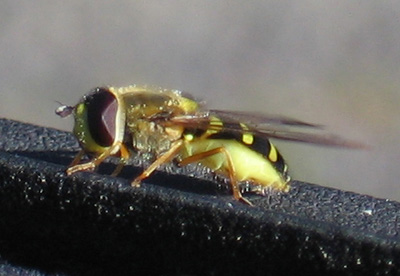
Comments to the author, Erin Thomas, are welcomed.
Mr. Thomas also studies poetry.
Microscopy UK Front Page
Micscape Magazine
Article Library
Please report any Web problems or offer general comments to the Micscape Editor.
Micscape is the on-line monthly magazine of the Microscopy UK web site at Microscopy-UK .